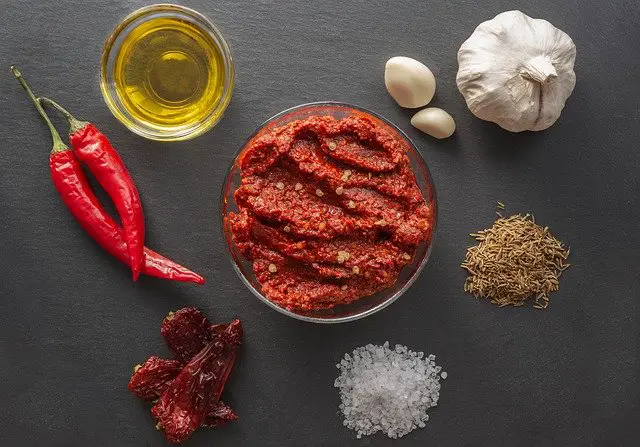Harissa is a hot chili that comes in both paste and powder form made from chili peppers that originated in Tunisia in North Africa. Commonly used as a dipping sauce used with olives and bread, as a dry rub for meats or on fish and also in stews and with roasted vegetables.
Traditional Tunisian harissa is made with a chili base comprised of mild, medium, hot and smoky chilis along with garlic, cumin, coriander and caraway seeds along with olive olive, salt and lemon juice also added. It’s a hot sauce used to spice up many sides and main courses and some people will substitute a hot sauce in place of harissa. Many hot sauces such as sriracha are pepper-based and thus taste differently but still bring the heat and are sometimes used in place or harissa if it’s not available.
I visited Tunisia in 2015 and although I’m generally not a hot foodie, my wife is (she’s Arab too) so she was trying out the harissa at the hotel restaurant regularly which was not difficult to locate.
Fun fact: Harissa when pronounced Har-ee-sa means the sauce that we’re talking about here in this article. Harissa when pronounced Har-ee-say refers to a sweet semolina-based Arabic dessert which is clearly very different. My wife makes it for me and it’s pretty awesome.
Harissa Uses
From the Arabic word harasa which means to crush or pound, harissa is made by crushing or pounding the ingredients into a paste. Once you’ve made the paste, harissa can be used on foods in a number of ways. Harissa powder is an alternative option that you can purchase where you add water before using and consuming it.
Condiment: Popular as a dipping sauce on chicken wings, chicken nuggets, shrimp and other baked or fried foods, harissa can be used to spice up foods such as these.
Marinade: Lamb, beef, pork and chicken all work well with a harissa marinade.
Grains: Often used with grains and couscous, this can then be served alongside one of the marinated meats mentioned above. Same goes with rice, quinoa, bulgur and farro.
Stew: Popular in stews, casseroles and in Moroccan Tajines, harissa can be added right to the pot’s liquid as it’s simmering.
Roasted Vegetables: Typically you brush the vegetables with olive oil before baking and then about 10 minutes before it’s done, brush the vegetables with harissa and finish the baking.
Lentils: Lentils are a popular Middle Eastern cooking ingredient used in soups and mains and both can use harissa to spice up the taste.
Sriracha

Sriracha is a hot sauce from Thailand and purportedly from the Thai town of Si Acha. It is typically used as a dipping sauce for chicken wings, fried foods and other foods that may require some heat such as the noodle dish shown above.
In restaurants you may get a small dish of it to add yourself or squirt it on the food from a bottle.
Harissa vs Sriracha Ingredients
While some people may use sriracha sauce as a substitute for harissa, they really are different sauces that only share a hot taste and one ingredient.
Here are two typical authentic recipes for Tunisian Harissa and Thai Sriracha so you can see the differences.
| Harissa Recipe | Sriracha Recipe |
| 4 oz dried chilies of mild, medium, hot and smoked varieties | 24 oz. fresh red jalapeño or serrano peppers |
| 6-8 peeled garlic cloves | 4 peeled garlic cloves |
| 1 tablespoon of cumin seeds | 4 fluid oz. of rice wine vinegar |
| 2 tsp of caraway seeds | 12 fluid oz. of water |
| 1 tablespoon of coriander seeds | 3 tablespoons of granulated sugar or brown sugar |
| 3 tablespoon of olive oil | 3 tablespoons of salt |
| 2 tsp of salt | |
| 1 tablespoon fresh lemon juice |
So while you can see one common ingredient in garlic the rest of the recipes are different. Harissa is chili-based whereas sriracha is jalapeño or serrano pepper based.
Harissa Substitutes

Can sriracha be substituted for harissa? It can be but the flavors aren’t the same. If you’re looking for the heat, then either product can be used in place of one another or another hot sauce for that matter. But the tastes of each one are different.
Hot sauces are often used as substitutes but again, they tend to be pepper based whereas harissa is chili-based. If you don’t have harissa handy or don’t have all the ingredients to make it yourself, you can substitute the following:
- Chopped red chilis with a pinch of caraway seeds with olive oil to make a paste.
- Chopped red chilis with ground coriander with olive oil to make a paste if you don’t have caraway.
- Chili powder used in a 1:1 ratio instead of the amount of required harissa.
- Berbere spice used in a 1:1 ratio instead of the amount of required harissa.
- Tandoori masala if you can find it as it can be difficult to procure.

